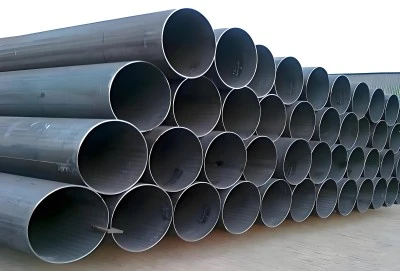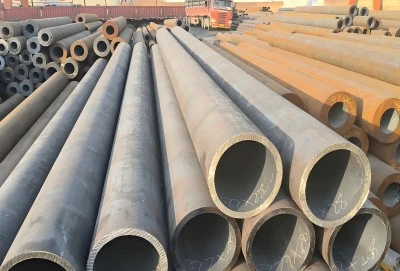When it comes to engineering and construction, precision is key. One of the critical measurements in the world of steel tubing is the outside diameter. This crucial dimension plays a significant role in determining the performance, strength, and suitability of hollow steel tubes for various applications. In this comprehensive guide, we'll explore the concept of outside diameter, its importance in steel tube engineering, and how it affects the mechanical properties of these versatile components.
|
|
|
Outside Diameter of Hollow Steel Tubes
The outside diameter (OD) of a hollow steel tube refers to the measurement of the tube's external circumference. It's the distance across the circle formed by the outer surface of the tube, passing through its center. This dimension is crucial for several reasons, including fit, function, and structural integrity.
When selecting hollow steel tubes for a project, engineers and designers must consider the outside diameter as it directly impacts:
- The tube's ability to fit within or around other components
- The overall weight and material usage of the structure
- The tube's resistance to external pressures and loads
- Compatibility with standard fittings and connectors
Its outside diameter can vary widely, depending on the intended application. For instance, in the oil and gas industry, large-diameter pipes are common, while smaller diameters might be used in automotive or aerospace applications. According to industry standards, hollow steel tube outside diameters can range from as small as a fraction of an inch to several feet for large-scale industrial uses.
Why is the Outside Diameter Critical in Steel Tube Engineering?
The outside diameter of a hollow steel tube is not just a number; it's a critical factor that influences various aspects of engineering design and performance. Here's why it's so important:
1. Structural Integrity
The outside diameter plays a crucial role in determining the overall strength and stability of a structure. Larger diameter tubes generally offer greater resistance to bending and buckling, making them suitable for load-bearing applications. Engineers must carefully calculate the required outside diameter to ensure the structure can withstand anticipated stresses and loads.
2. Material Efficiency
By selecting the appropriate outside diameter, engineers can optimize material usage. This not only reduces costs but also minimizes the overall weight of the structure. In industries where weight is a critical factor, such as aerospace or automotive, choosing the right outside diameter can lead to significant improvements in fuel efficiency and performance.
3. Fluid Dynamics
In applications where hollow steel tubes are used to transport fluids or gases, the outside diameter influences flow characteristics. It affects factors such as pressure drop, flow velocity, and turbulence. Engineers must consider these aspects when designing piping systems for optimal performance.
4. Thermal Considerations
The outside diameter impacts the tube's ability to transfer heat. In heat exchanger applications or in situations where thermal expansion is a concern, the choice of outside diameter can significantly affect system efficiency and longevity.
5. Compatibility and Standardization
Many industries rely on standardized tube sizes for ease of integration and replacement. The outside diameter is a key factor in ensuring compatibility with fittings, connectors, and other system components. Adhering to standard sizes facilitates maintenance and reduces the need for custom parts.
How Does the Outside Diameter Affect the Mechanical Strength of Hollow Tubes?
The outside diameter of a hollow steel tube is intrinsically linked to its mechanical properties. Understanding this relationship is crucial for engineers and designers aiming to create structures that are both strong and efficient. Let's explore how the outside diameter influences various aspects of a tube's mechanical strength:
1. Moment of Inertia
The moment of inertia is a measure of a tube's resistance to bending. It increases exponentially with the outside diameter. This means that a small increase in outside diameter can lead to a significant improvement in the tube's ability to resist bending forces. This property is particularly important in applications where the tube must support lateral loads or span large distances.
2. Buckling Resistance
Buckling is a mode of failure where a structural member suddenly deforms under compressive stress. The outside diameter of a hollow steel tube directly affects its resistance to buckling. Tubes with larger outside diameters generally have higher critical buckling loads, making them more suitable for applications where compressive forces are significant.
3. Torsional Strength
When it comes to resisting twisting forces, the outside diameter plays a crucial role. The torsional strength of a hollow tube increases with its outside diameter. This is particularly important in applications such as drive shafts or structural members subject to rotational forces.
4. Weight-to-Strength Ratio
One of the key advantages of hollow steel tubes is their excellent weight-to-strength ratio. By carefully selecting the outside diameter in relation to the wall thickness, engineers can create structures that are both strong and lightweight. This is particularly valuable in industries where weight reduction is a priority, such as aerospace and automotive engineering.
5. Stress Distribution
The outside diameter affects how stresses are distributed throughout the tube. In general, a larger outside diameter allows for a more even distribution of stresses, which can lead to improved overall strength and durability of the structure.
Outside Diameter vs. Nominal Diameter
When discussing hollow steel tubes, it's important to distinguish between outside diameter and nominal diameter. While these terms are sometimes used interchangeably, they have distinct meanings:
- Outside Diameter (OD): This is the actual measured diameter of the tube's outer surface.
- Nominal Diameter: This is an approximate size used for identification purposes and may not correspond exactly to any physical dimension of the tube.
For example, a tube with a nominal diameter of 2 inches might have an actual outside diameter that's slightly different. The relationship between nominal and actual sizes can vary depending on the manufacturing standard and the specific application.
Understanding this distinction is crucial when specifying or ordering hollow steel tubes. Always clarify whether you're working with actual outside diameters or nominal sizes to ensure you get the right product for your needs.
China Hollow Steel Tubes Supplier
The outside diameter of a hollow tube is far more than just a measurement; it's a critical factor that influences structural integrity, performance, and efficiency across a wide range of applications. From determining mechanical strength to ensuring compatibility with standard fittings, the outside diameter plays a pivotal role in engineering design and construction.
As we've explored, the choice of outside diameter affects everything from a tube's resistance to bending and buckling to its weight-to-strength ratio and stress distribution characteristics. By understanding these relationships, engineers and designers can make informed decisions that lead to safer, more efficient, and more cost-effective structures.
Whether you're working on a large-scale industrial project or a precision aerospace application, the importance of selecting the right outside diameter for your hollow tubes cannot be overstated. It's a decision that impacts not just the immediate performance of your structure, but its long-term durability and sustainability as well.
For those in need of high-quality hollow steel tubes with precise specifications, Longma Group is a leading manufacturer in China. With expertise in producing hollow tubes in grades S235, S275, and S355, outer diameters ranging from 3" to 80", and thicknesses from SCH10 to SCH160, Longma Group is committed to providing excellent products and services tailored to your specific requirements. Whether you need a small quantity or up to 150 tons, their team is ready to assist you in finding the perfect tube solution for your project. Contact us at info@longma-group.com.














